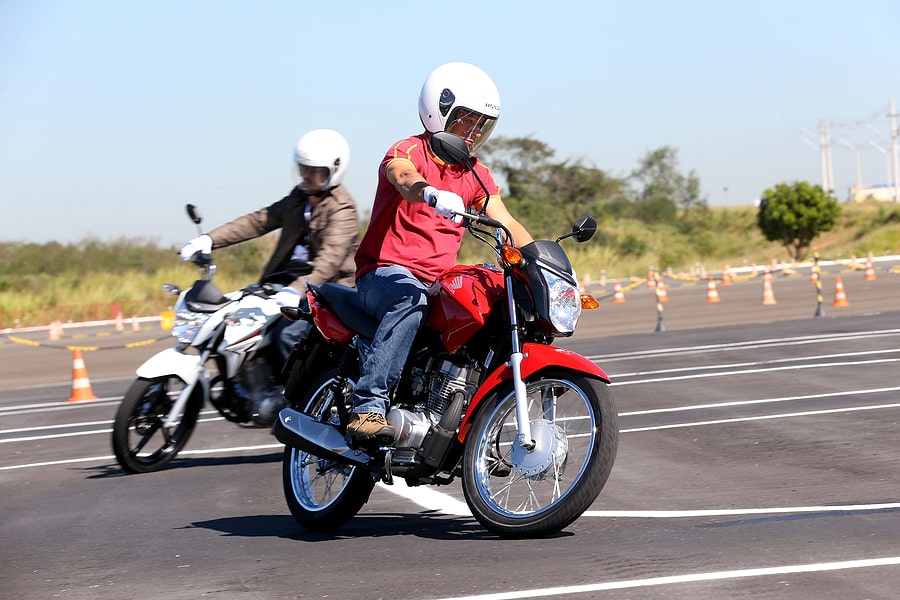
Did you know that the California Highway Patrol (CHP) administers motorcyclist training courses for riders of all ages and experience levels? If you ride motorcycles but haven’t yet taken it, you should.
Here’s what you need to know about CHP motorcycle courses and how they can help you become a better, safer rider.
Overview of the California Motorcyclist Training Program (CMTP)
Under California law, the CHP has a legal obligation to administer a statewide motorcyclist training program courses aimed at teaching basic and advanced skills to riders of all ages and experience levels. The program aims to promote motorcycling safety and responsibility.
CHP personnel do not teach CMTP directly. Instead, CHP has a contract with Total Control Training, Inc., a private motorcycle instruction provider, to offer and run CMTP courses throughout the state. Total Control Training offers two basic types of courses: a basic course for novice riders, and a “Premier” course for experienced riders looking to sharpen their skills in the saddle.
Total Control Training offers courses in dozens of locations throughout the state, from Eureka to Chula Vista and everywhere in-between. Click here, or call 1-(877) RIDE-411, to learn about the times and locations of current CMTP courses, and to sign up.
According to the CHP, since CMTP’s inception in 1987, over 1.2 million riders have learned or sharpened their motorcycling skills by taking a CHP motorcycle course.
Benefits of Taking a CMTP Course
Taking a motorcyclist training course through CHP and CMTP makes good sense for any rider who wants to take to the road in California on two wheels.
To begin, you must take a CMTP course if you are under 21, and you want to obtain a California motorcycle license or endorsement on your California driver’s license. To take the course, you must have a valid license, learner’s permit, or DMV-issued identification card. If you are under 18, you must also have written permission from a parent or guardian.
California law does not require you to take a CHP motorcyclist course if you are over 21 and seeking a license, but taking a course can certainly help you meet the minimum requirements and make you safer on the road in the process. In fact, even if you have years of experience riding a motorcycle, and you have a license already, taking CMTP courses can help hone your skills and make you a better, more responsible rider.
Finally, taking a CHP motorcycle course has additional benefits for riders of all ages, including:
- By completing a course successfully, you obtain a waiver of the requirement to pass the skills test required to obtain a motorcycle license or endorsement. This doesn’t mean you will automatically obtain a license by taking a course. It does, however, mean that you will only need to pass the written portion of the California motorcyclist test to get your license/endorsement.
- Completing a course may earn you financial breaks from your motorcycle insurance company in the form of lower premiums or deductibles.
- Completing a course gives you and your family the peace of mind of knowing that you remain up-to-date on the latest skills, rules of the road, and motorcycling technologies.
Course Costs, Logistics, and Equipment
According to the current CMTP website, a course costs no more than $350 for riders 21 and over and no more than $295 for riders 20-and-under. These fees do not include the fees associated with applying for a California motorcycle license or endorsement.
Beginner courses usually run for 15 hours over three days. “Premier” courses for experienced riders usually consist of 8 hours of instruction on one day.
As for equipment, CMTP supplies the motorcycles that students use during the course. It also supplies DOT safety standard-compliant helmets for students who do not have them (and inspects student-owned helmets to ensure compliance). According to CMTP, students need only bring “eye protection, a long-sleeved shirt or jacket, full-fingered gloves, long pants and sturdy over the ankle footwear (not canvas).”
Why Motorcycle Accident Lawyers Love CHP-Approved Motorcycle Courses
Attorneys for bikers who get injured in motorcycle accidents love it when their clients have taken a CMTP motorcyclist safety and skills course. Here’s why.
Under California law, anyone who suffers injuries and losses because of someone else’s wrongful decisions or actions has a legal right to seek compensation from the at-fault party.
Through lawsuits and insurance claims, lawyers for injured motorcycle accident victims can secure compensation to pay for:
- Medical costs associated with treating their motorcycle accident injuries.
- Other costs they incur because of the wreck and their injuries.
- The wages and income they do not or will not earn because of their injuries.
- Their pain, suffering, loss of quality of life, and interference with their personal relationships.
Obtaining compensation for motorcycle wreck victims doesn’t always prove to be a straightforward process, however. As you might imagine, the parties at fault for causing a wreck, and their insurance carriers, often fight back to try to avoid financial accountability to injured bikers. One tactic these companies commonly resort to consists of blaming the biker—that is, arguing or insinuating that the motorcyclist made a mistake that triggered a crash, or suggesting that the biker was somehow asking to get injured by riding a motorcycle to begin with.
Those arguments generally consist of nonsense, but lawyers still need to respond to all defensive claims. This is where a biker having taken a CMTP course comes in handy. It’s harder to argue that an injured biker’s error caused a wreck when that biker has passed the CHP-approved skills and safety course. Graduating from a course constitutes a seal of approval that tells the world that a motorcyclist understands and follows the rules of the road and good safety practices. It makes the biker’s version of events of how a crash unfolded more believable in a “he-said-she-said” battle over who bears the fault for a wreck.
In other words, California motorcyclists can think of taking a CMTP course as a type of extra insurance that protects their right to compensation for an accident that someone else caused. Taking a course constitutes a defense against the unfortunate, but all-too-common, bias that insurance companies and juries sometimes have against motorcycling. It shows the motorcyclist cares about safety, acts responsibly, and should receive maximum compensation for a motorcycle accident injury.
You’ve Suffered Injuries in a Motorcycle Accident. Now What?
Unfortunately, even the most skilled and safety-conscious motorcyclists can get into serious accidents. Taking a CHP motorcycle course can help to ensure that you don’t make mistakes on the road, but other motorists’ errors can still put you at risk.
The steps you take after a motorcycle accident can affect your well-being and your rights. To supplement any advice you may have learned in your CMTP safety course, we discuss some tips below that you should follow to protect yourself physically, legally, and financially.
Call 911 and Stay at the Accident Scene
Always report any accident to the local authorities by calling 911. The law requires this in most accidents, and doing so will summon first responders who can prepare a report and render any necessary medical aid.
Following an accident, you and/or your motorcycle will likely have suffered damage, so you probably won’t get right back on your bike immediately after a crash. Even if you physically could ride away from the accident scene, however, you should stay put and wait for the first responders to arrive. Leaving the scene of an accident can constitute a crime, and it virtually always puts your legal rights to compensation for your injuries at risk.
When first responders arrive, you should cooperate with them, but also stick to the facts when answering questions about the accident. You shouldn’t discuss who you think caused the accident or blame yourself for what happened during these conversations. Keep your answers accurate and to the point.
Seek Medical Attention
Let an EMT examine you at the accident scene and follow any suggestions for care that the EMT gives you. That includes leaving the scene in the ambulance to receive care at a local hospital emergency room. The moments after a motorcycle accident don’t constitute the time to refuse medical attention or to try to tough it out through the pain.
Even if an EMT signs off on you leaving the scene under your own power, seek medical care within no more than 24 hours, regardless of how hurt you feel. Never assume that you escaped a motorcycle wreck without injury. Some severe injuries may not show symptoms right away, but rather need immediate treatment to prevent serious complications.
Getting medical attention protects your health, first and foremost. But it also serves an important legal and financial purpose. By letting a doctor check you out, medical records will detail your injuries and their connection to the accident. Those records may provide essential evidence in securing you the money you deserve to receive as damages from the party at fault for the crash.
Preserve Records and Evidence of What Happened
In the days and weeks following a harmful motorcycle accident, you will likely receive documents from your doctors and insurance carriers, including bills, statements of benefits, and records of your treatment. Keep these in a safe place. Do not throw them away, as they may contain important information that you will need to obtain compensation for your injuries.
In the same vein, also take steps to hold on to physical items related to the wreck. Keep your clothes from the accident, even if ripped, torn, or soiled. Keep your motorcycle “as is”—don’t take it to a shop for repair or send it to the dump—until a lawyer representing you has had a chance to have it examined by an expert. These items, too, could constitute critical evidence that helps you obtain money from the at-fault parties.
Contact an Experienced Motorcycle Accident Lawyer
Finally, as soon as you have addressed your immediate medical needs, contact an experienced motorcycle accident attorney. You have no time to lose in enlisting legal help with getting maximum compensation given the specific circumstances of your accident. The sooner you connect with a skilled lawyer who can represent your interests with insurance companies and defense lawyers, the stronger your chances of obtaining full and fair compensation for the injuries and losses you have suffered.
If you wait too long to contact a lawyer, you could put your legal and financial rights at risk. A law called the statute of limitations puts an expiration date on your legal rights to seek damages from the parties at fault for the wreck. Allowing that date to pass without having taken legal action can result in the loss of your rights altogether.
By connecting with an attorney immediately, you allow the attorney to take immediate steps to protect your rights.
For example, an attorney can:
- Act quickly to preserve important evidence of the motorcycle accident that’s in the hands of other parties, such as traffic camera footage of the accident or data from a vehicle’s onboard computer.
- Take over interactions with your insurance company and any insurers representing the other motorists or individuals involved in the accident.
- Represent your interests in any interactions with official or private investigators.
- Bring in expert investigators to examine the evidence of the accident to determine how it happened and who should pay you damages for your injuries and losses.
- Prepare, file, and pursue timely legal action on your behalf to pursue maximum compensation, either through a negotiated settlement or at a trial in front of a judge and jury.
For the most part, you shouldn’t try to handle these legal proceedings on your own. In the aftermath of a motorcycle accident, healing from your injuries typically requires your full effort and attention. Let an experienced San Diego motorcycle accident attorney represent your rights so that you can focus on your physical and emotional recovery.
Motorcycle Safety Starts With the Knowledge a CHP Motorcycle Course Provides
If you ride a motorcycle in California, we encourage you to take full advantage of a CHP motorcycle course in your area. It’s the responsible thing to do for yourself, your family, and your community, and in the unfortunate event of an accident, it can enhance your legal and financial rights.







